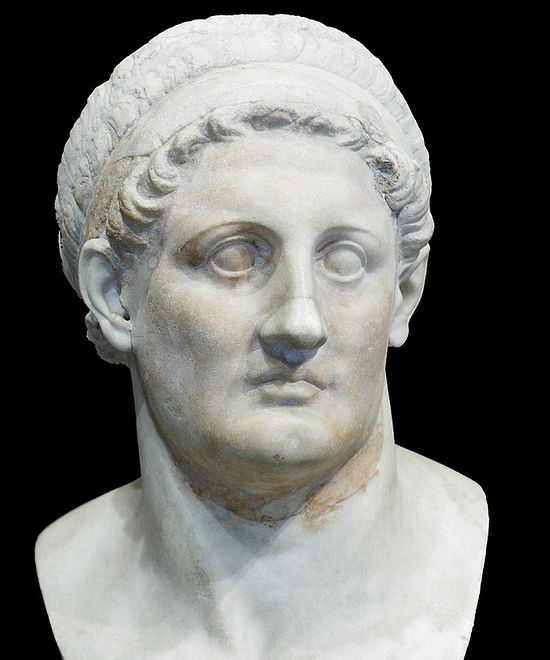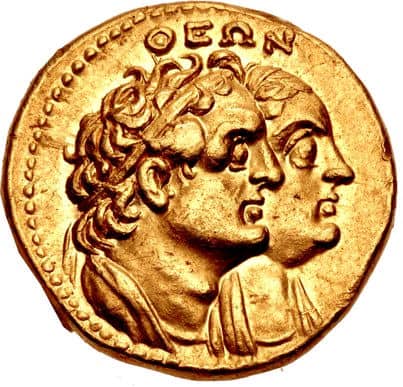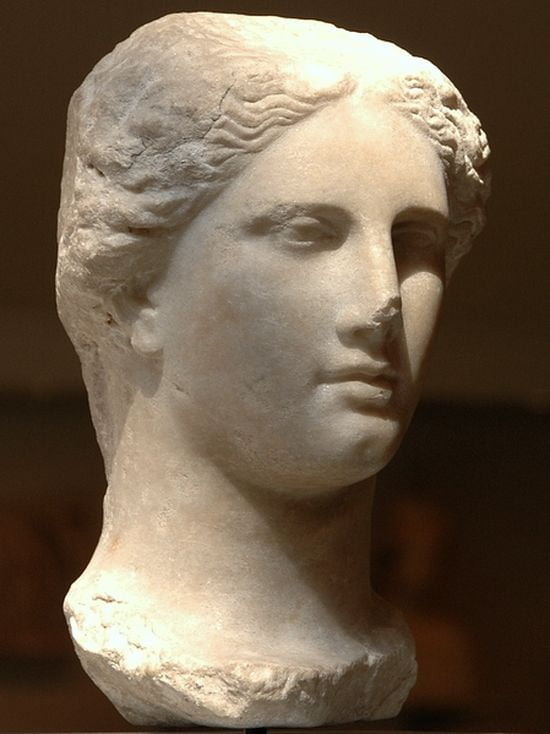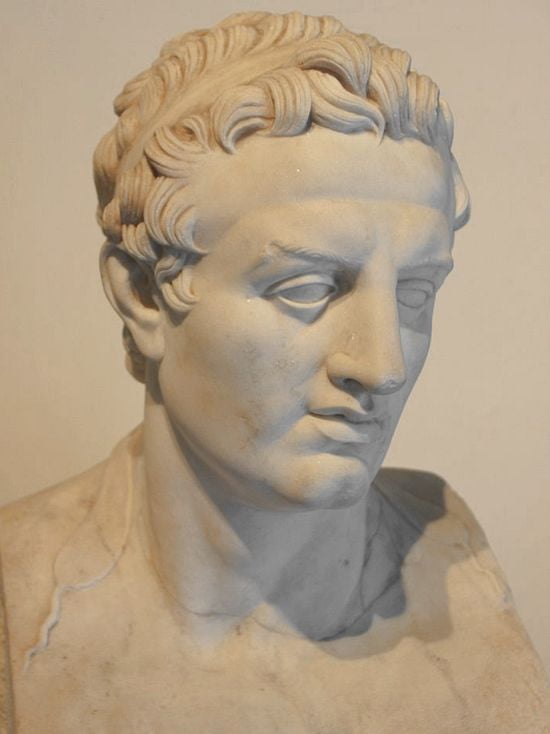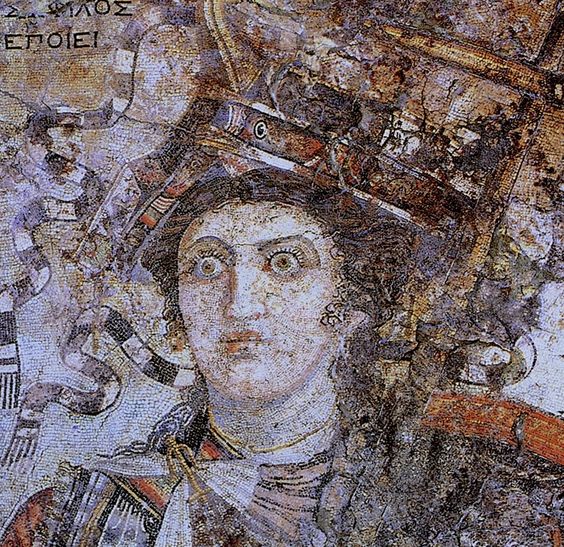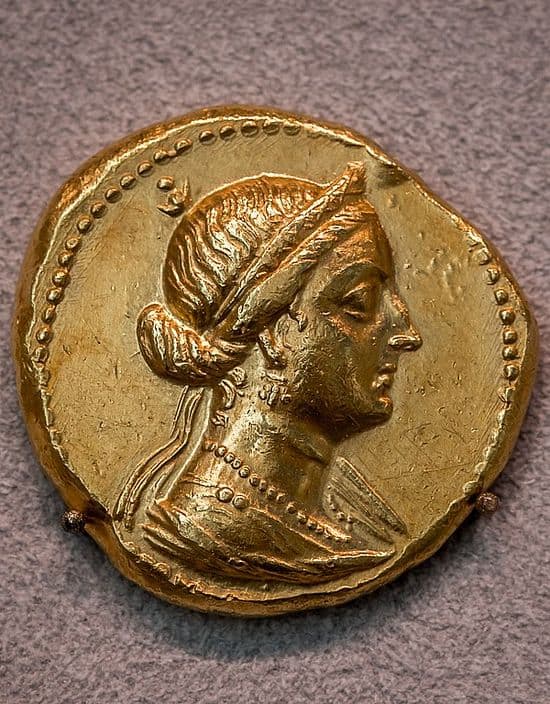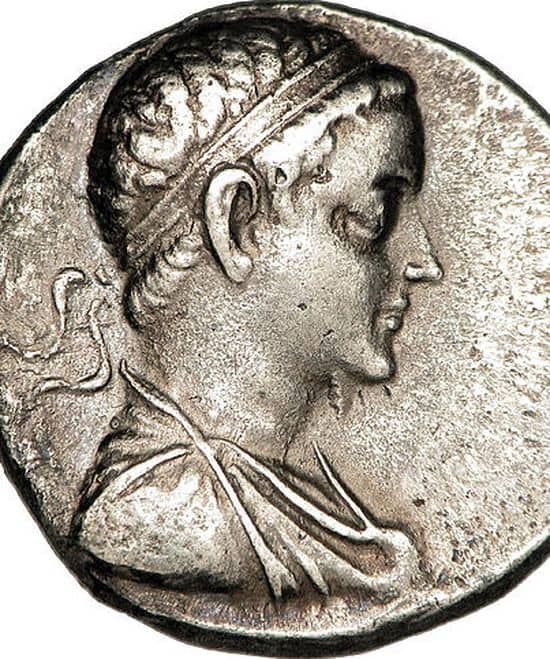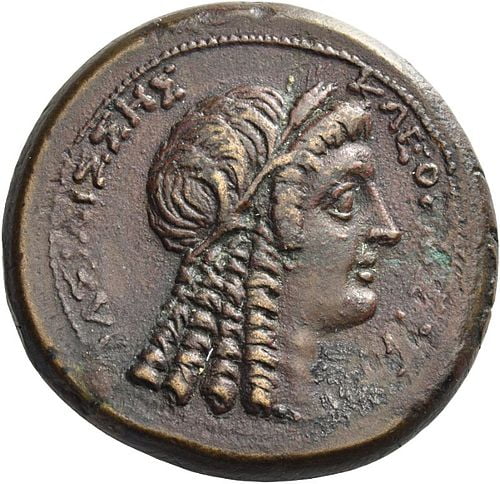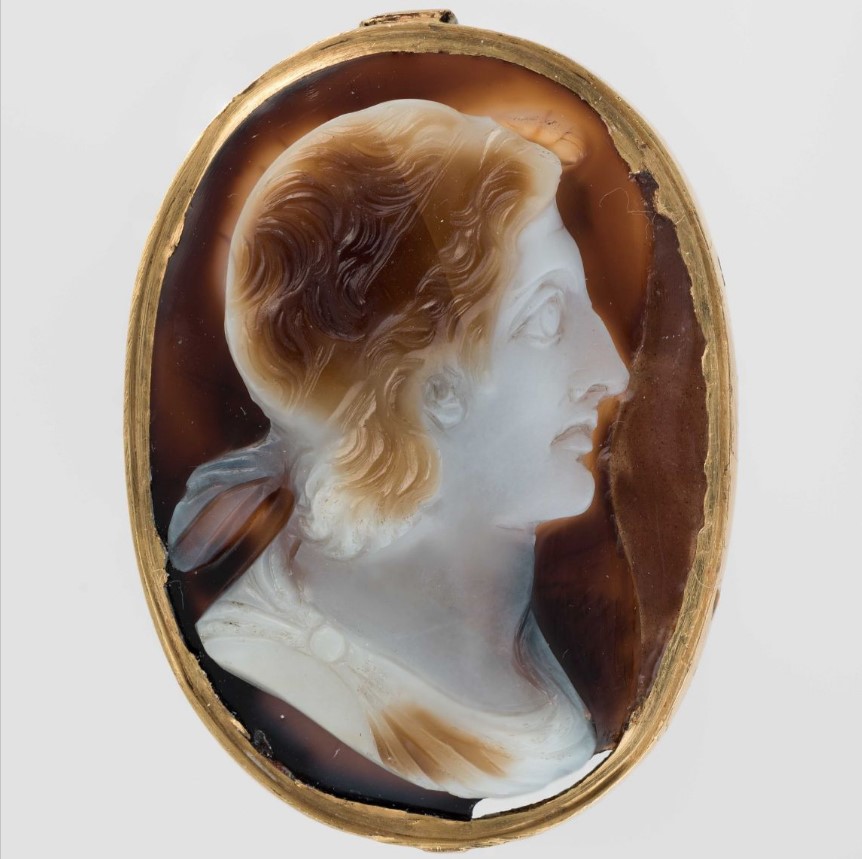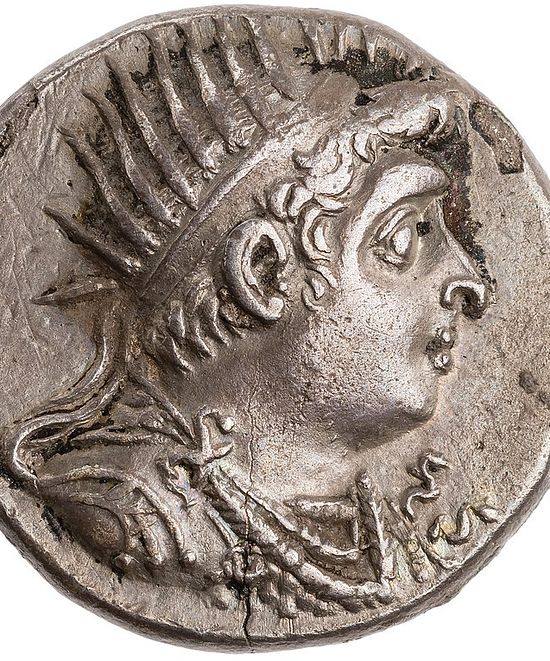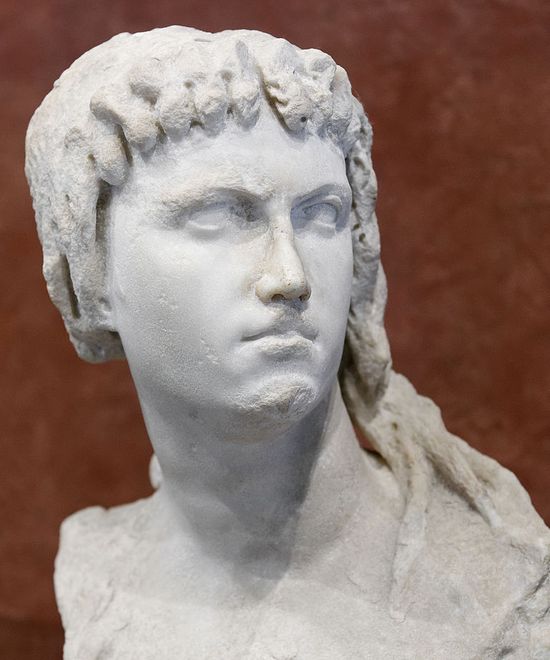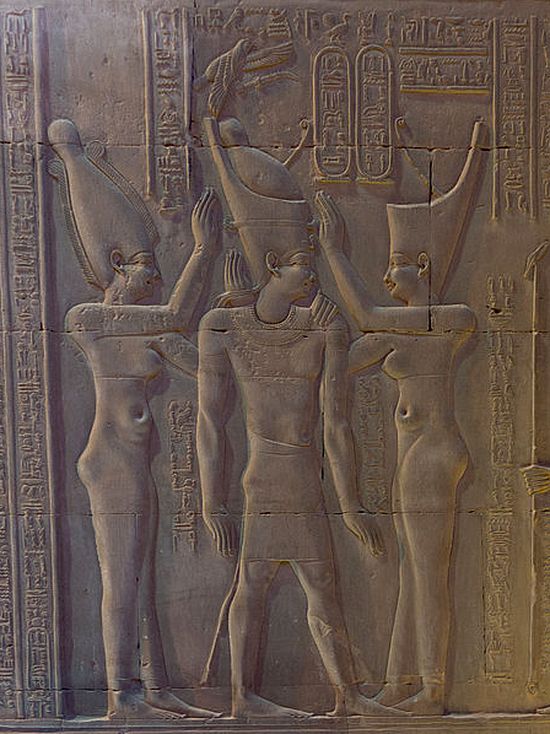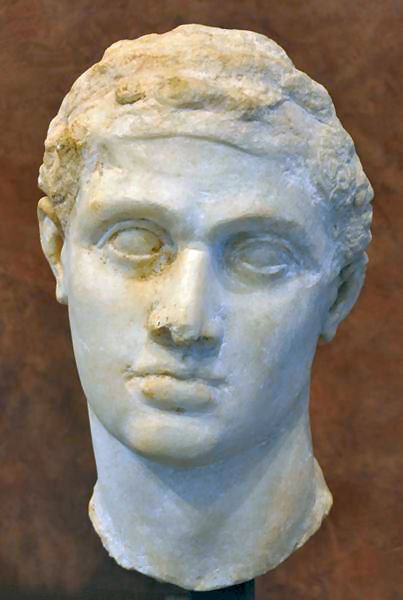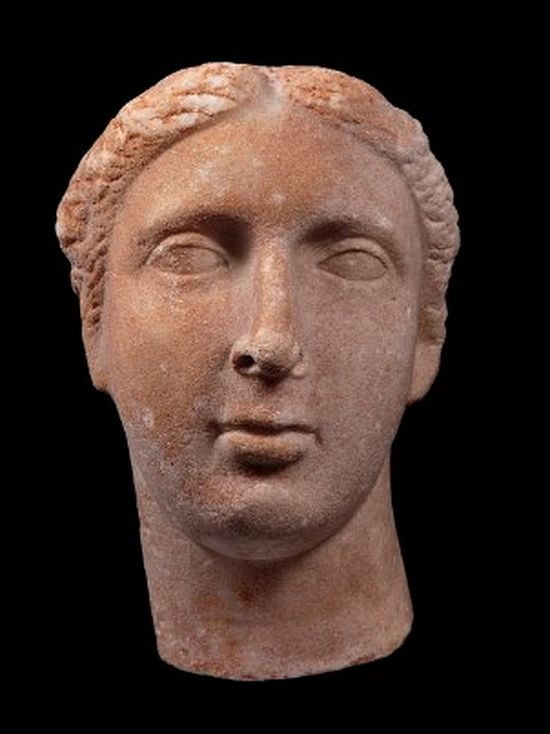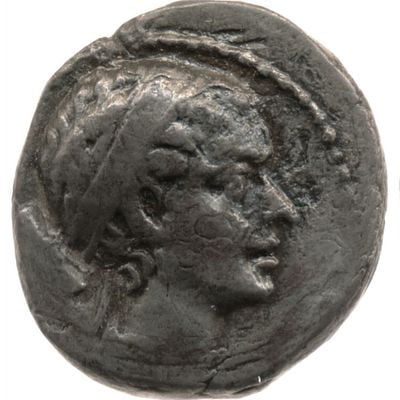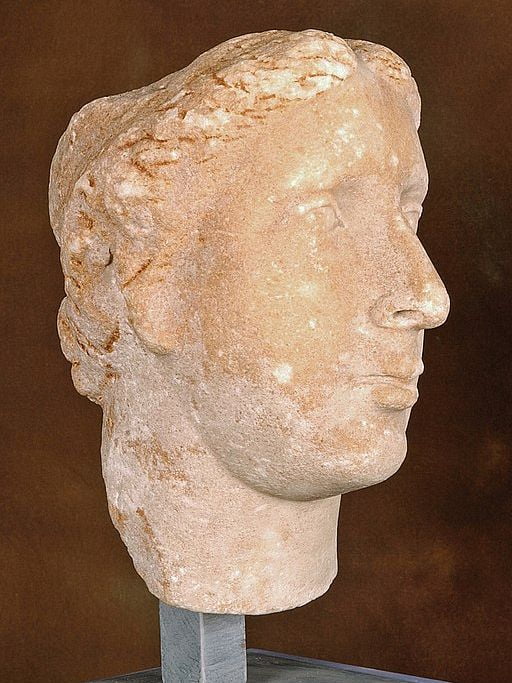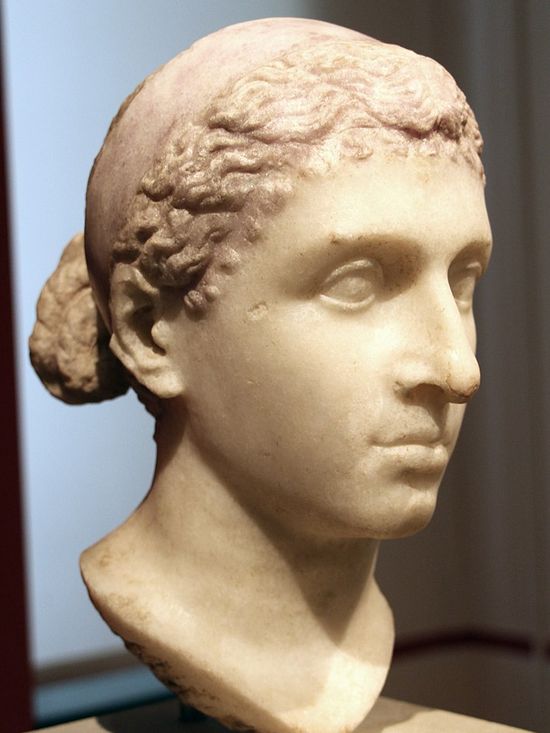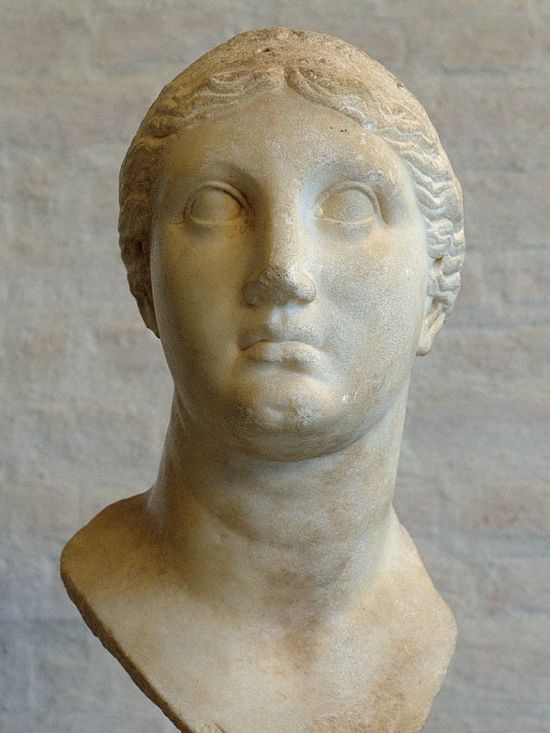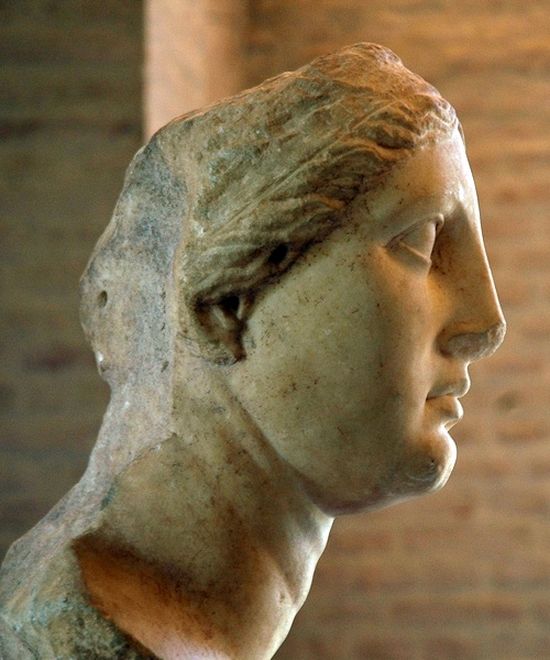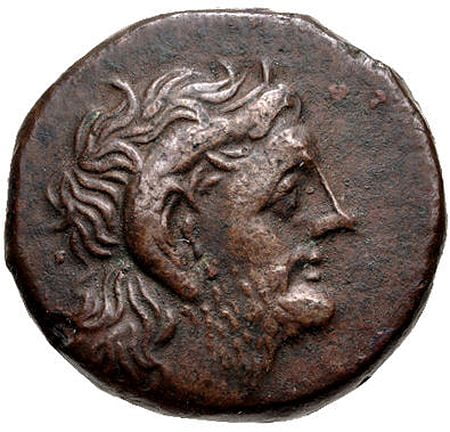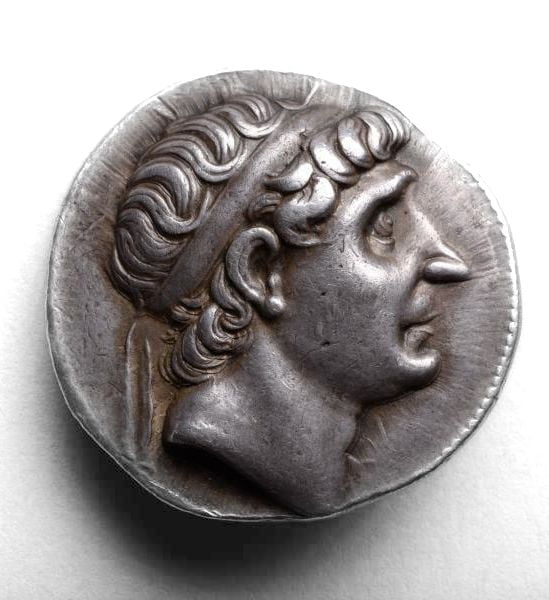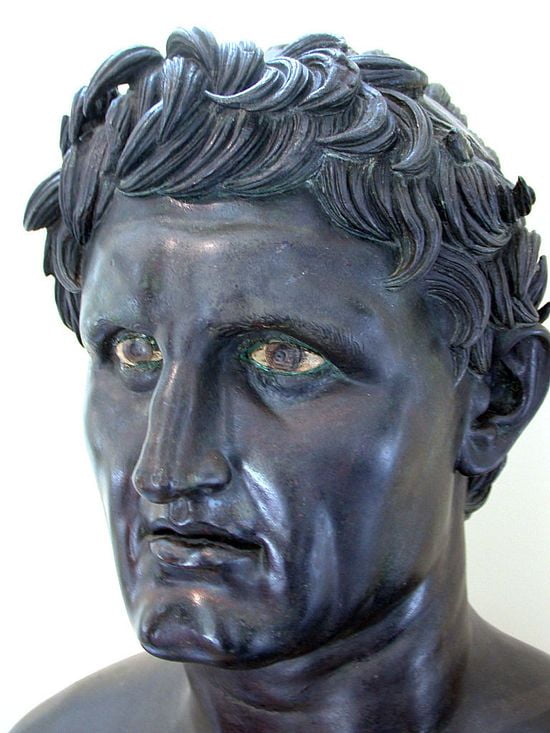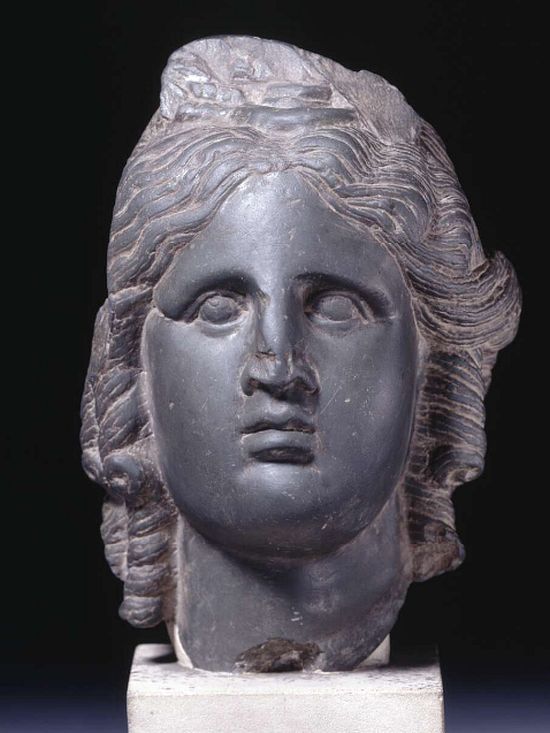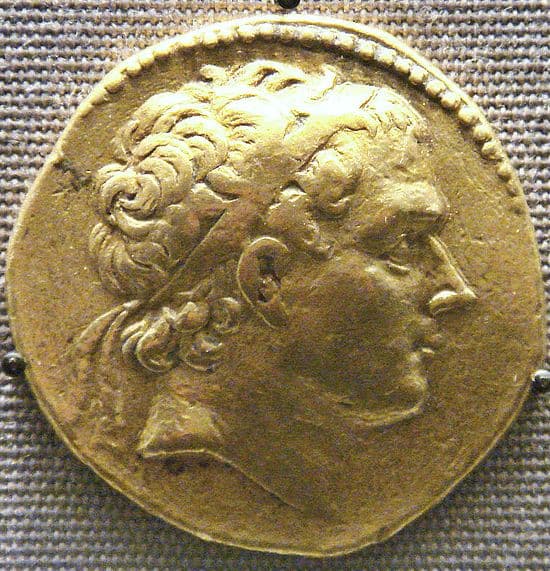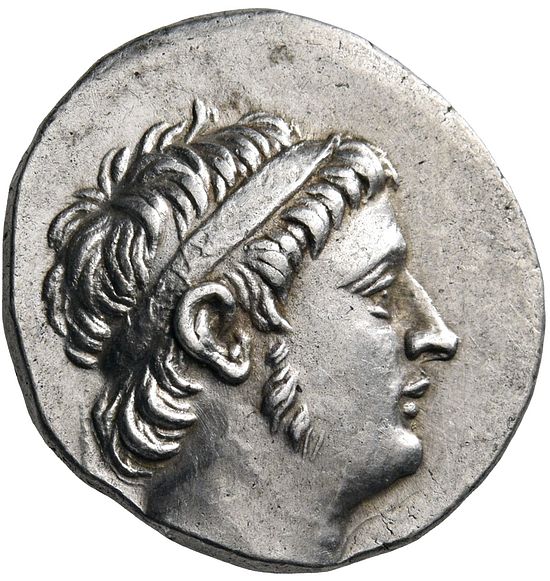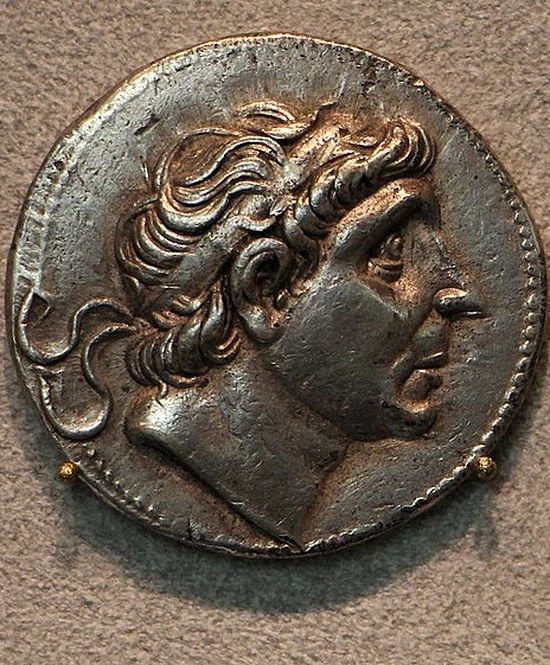Cleopatra’s family tree is a who is who of the Greek world. She descended from the kings of Egypt, Macedon, Greece, Thrace, Pontus, Cyrenaica, Asia Minor, and the Seleucid Empire.
The Romans, like Julius Caesar, were dazzled with Cleopatra’s lineage. Here is her family tree*:
The paternal line: the Ptolemies
Cleopatra’s highly inbred family. Most of the Ptolemies married their full-sisters or close relatives. (Hover the mouse over the pictures to see their names or click them to open the gallery.)
Cleopatra’s family hailed from Macedon, in Europe. Back then, Macedon was an independent kingdom, but nowadays, most of its territory is in Greece.
So how come the Macedonians ended up in Egypt? Well, it was the fault of Alexander the Great.
In the 4th century BC, Alexander was the king of Macedon. He was an extraordinary military man who dreamt of world domination. So he conquered the huge Persian Empire, which had territories in Asia and Africa.
When he died, his generals partitioned his empire. And each of these generals became the king of a region of the former empire.
Ptolemy I

Ptolemy Lagus was one of these generals. In the partition, he grabbed Egypt and became its pharaoh.
Ptolemy was Cleopatra’s ancestor.
Ptolemy founded the Ptolemaic dynasty in Egypt. His descendants ruled the country for the next 300 years.
There were 9 generations between Ptolemy and the last Ptolemaic queen, Cleopatra VII.
Ptolemy was from Macedonia. And his parents, too, were Macedonian nobles: Lagus and Arsinoe.
So Ptolemy, now pharaoh of Egypt, had no royal blood.
To give his family more glamour, he circulated the gossip that he was the illegitimate son of King Philip II of Macedon.
So Ptolemy was claiming to be Alexander the Great‘s half-brother. That would have also made him the descendant of a long line of Macedonian kings.
But that is probably not true. Ptolemy was likely the son of Lagus. Lagus was his official father and the husband of his mother Arsinoe. Ptolemy’s name was ‘Ptolemy son of Lagus.’ That is how the sources refer to him, and that is the name he used while his friend Alexander was alive.
After becoming pharaoh, Ptolemy took the name of Ptolemy I Soter. And he married Berenice I, a Macedonian noblewoman (her family tree is below). This is the couple that founded the Ptolemaic dynasty.
Their son was King Ptolemy II of Egypt.
Ptolemy II
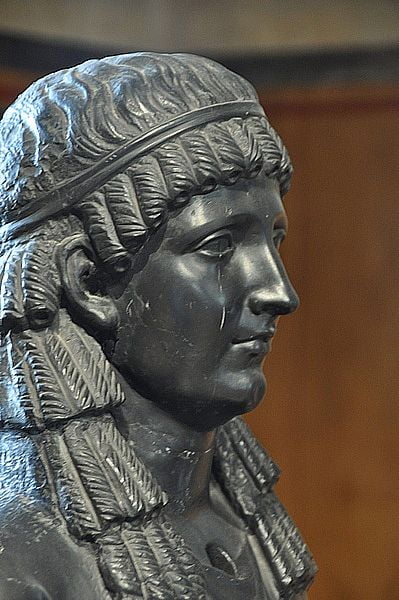
Ptolemy II first married Arsinoe I (family tree below).
Arsinoe, like Ptolemy II himself, was the daughter of one of Alexander’s generals-turned-kings: Lysimachus.
Ptolemy and Arsinoe had several children, including the future Egyptian king Ptolemy III. But their marriage did not last.
Ptolemy II exiled his wife. And then, he married his full-sister Arsinoe II.
Now, this marrying-your-full-sister-thing was a tradition of the old, native pharaohs of Egypt. But in Greece, it was considered incest. So, cleverly, Ptolemy II waited until his kingly father died, and then married his sister Arsinoe II, who apparently, he was in love with. The Greeks that lived in Egypt were scandalized.
Most of his descendants followed his example and married their sisters.
In the 300 years that the Ptolemies ruled Egypt, only two other kings did not marry their close relatives: Ptolemy III and Ptolemy V. Not for lack of trying, though. They simply did not have surviving sisters.
Back to the family tree, siblings Ptolemy II and Arsinoe II were now married. And Arsinoe II adopted her husband’s children, including Ptolemy III.
That is why King Ptolemy III always appears as Arsinoe II’s son. But biologically, he was the son of Arsinoe I.
Ptolemy III

Arsinoe II’s adoptive son, Ptolemy III, was short of sisters.
His only legitimate half-sister had married the king of the Seleucid Empire and, more irrevocably, had died.
So he had to marry outside his immediate family. He chose his first cousin Berenice II (her family tree is below). She was the ruling queen of Cyrenaica.
Ptolemy III and Berenice II were cousins because they were both grandchildren of Berenice I -the wife of Ptolemy I Soter mentioned above.
The cousins had a son, Ptolemy IV.
Ptolemies IV, V, VI, VIII
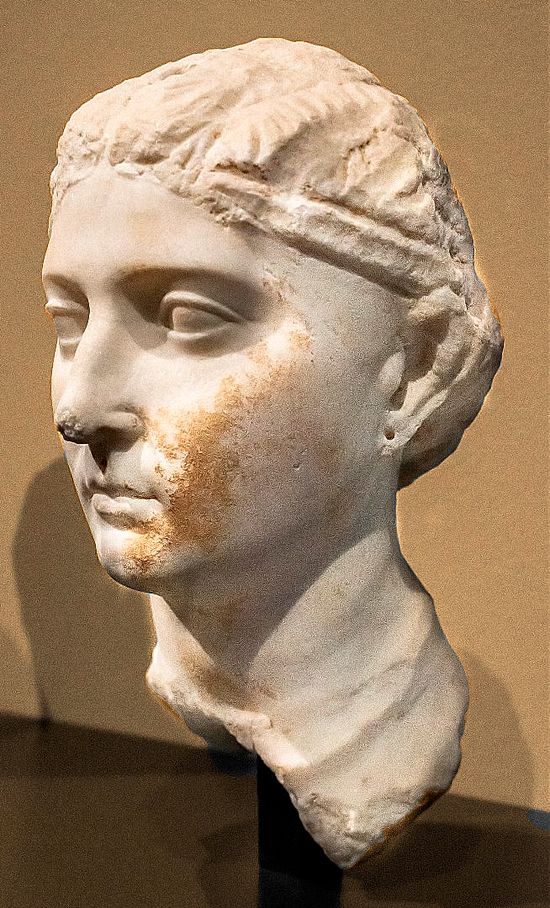
Ptolemy IV married his full-sister Arsinoe III. And they had a son, Ptolemy V.
Ptolemy V did not have legitimate sisters. Not even one. So he married a foreigner. He was the last of Cleopatra’s ancestors to take a foreign wife.
He chose Cleopatra I, a princess of Syria (her family tree is below). But, of course, she was also heavily related to the Ptolemies. She was a close relative to her husband’s ancestresses Berenice I and Berenice II.
Ptolemy V and his semi-foreign queen, Cleopatra I, had three children that are of interest here: Ptolemy VI, Cleopatra II, and Ptolemy VIII.
Ptolemy VI married his full-sister Cleopatra II. And they had a daughter: Cleopatra III.
Then, their sibling Ptolemy VIII, who was a cruel man and, by all accounts, an envious brother, married that daughter. That is, Ptolemy VIII married his niece Cleopatra III.
The uncle-nice duo produced a son: Ptolemy IX. This king was ‘our’ Cleopatra’s grandfather.
Up to here, the genealogy of the family is well-documented. But from here on, only the paternal line can be traced with certainty.
Ptolemies IX and XII
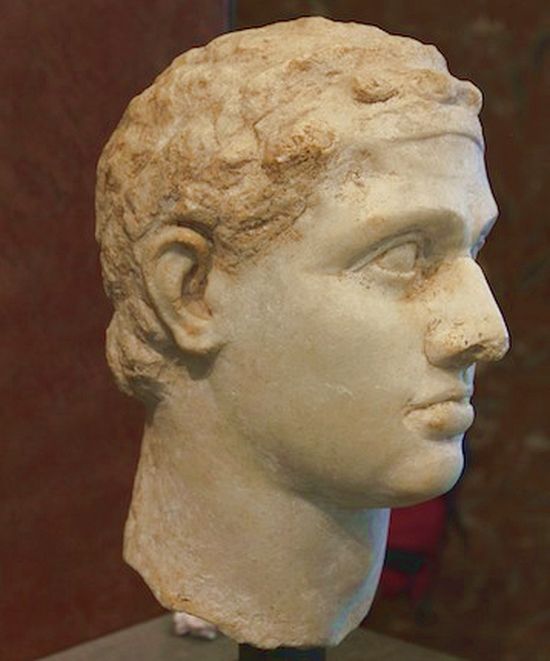
Cleopatra’s grandfather, Ptolemy IX, married his two full-sisters. But it is highly unlikely that his son, Ptolemy XII, was the son of either queen. He seems to have been illegitimate.
Apparently, the Egyptians run out of legitimate Ptolemies to put on the throne. They had just lynched their last legitimate king (Ptolemy XI), who had been backed by Rome.
So, in a hurry, before the always looming Romans swept in and annexed Egypt, the Alexandrines called Ptolemy XII to the country. He had been living in Asia.
That he was the son of King Ptolemy IX is certain. But there is no evidence that he was the son of one of the queens. And both Egyptians and Romans called him “bastard” (Ptolemy Nothos).
This Ptolemy XII was Cleopatra’s father.
Cleopatra’s mother
Most likely, Queen Cleopatra Tryphaena was Cleopatra’s mother, but it is not certain. Cleopatra V Tryphaena, left; Cleopatra VII, right.
Ptolemy XII married his sister Cleopatra V Tryphaena. She may have been his full-sister or a half-sister. In this Ptolemaic generation the details are, oddly, rather murky.
It is not clear, either, if this Tryphaena was Cleopatra’s mother. She most likely was, according to scholars. But there is no hard evidence of it at this time.
Therefore, Cleopatra’s family tree is complete only until it reaches her grandfather, Ptolemy IX. Then, there are two lagoons: who was her grandmother, and who was her mother.
Read next: Cleopatra’s Ethnicity: Was She Black, White, or Mixed?
The four foreign brides of the Ptolemies
These four women were related to one another. And three of them were also close relatives of the Ptolemies themselves.
Berenice I. The Macedonian wife of Ptolemy I

Berenice’s family. Her great-uncle was powerful Antipater, the regent of the Macedonian Empire and former general of Alexander the Great. Philip was her first husband. Three of Berenice’s children – Magas, Ptolemy II, and Arsinoe II- are ancestors of Cleopatra.
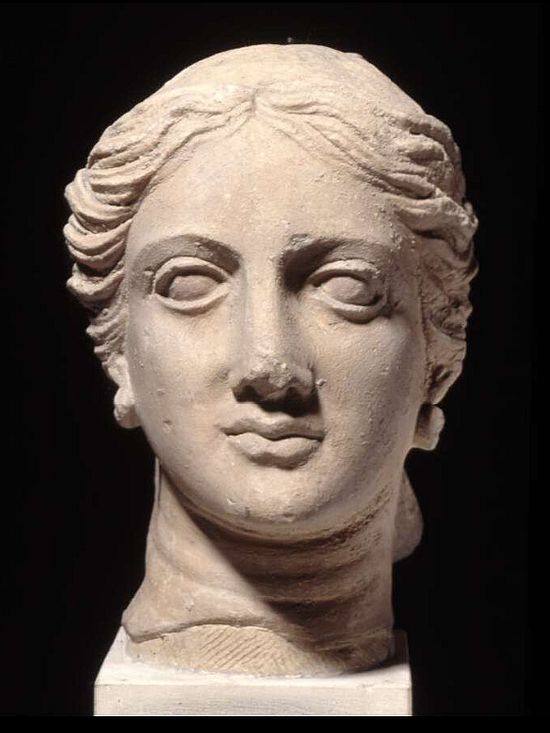
Ptolemy I Soter married Berenice I. And the duo founded the Ptolemaic dynasty.
Berenice was Macedonian. Her father was Magas of Macedon, a nobleman from Eordaea, a region in Macedon.
And Berenice’s mother was a very well connected noblewoman: Princess Antigone of Macedon.
Antigone’s uncle was no other than Antipater, the powerful regent of the Macedonian Empire.
Antipater had been friends with King Philip II of Macedon. And after Philip’s death, he had served his son, Alexander the Great.
When Alexander crossed to Asia to conquer the Persian Empire, Antipater was left behind as regent of Macedon.
After Alexander’s death, Antipater kept ruling Macedon. And then, Antipater’s son, Cassander, became King of Macedon.
So Berenice was the niece of one king of Macedon (Cassander) and, after his death, the cousin of another (Alexander V of Macedon).
Berenice’s non-Ptolemaic children
Now, Ptolemy was not Berenice’s first husband. She had been married to a Macedonian nobleman, Philip of Macedon. And they’d had three children: two girls and a boy.
After her husband died, she married Ptolemy. Soon, he made her three children royals. One daughter was married to the famous king of Epirus, Pyrrhus. The other was married to the king of Sicily.
And Ptolemy made Berenice’s son, Magas, the king of Cyrenaica. This North African territory belonged to Egypt, but Ptolemy made it independent to give it to Magas.
This is relevant because this Magas of Cyrene will show up in Cleopatra’s family tree soon.
Arsinoe I. The replaced wife of Ptolemy II

Arsinoe’s ancestors. In blue, Alexander’s generals-turned-rulers: Lysimachus and Antipater. Lysimachus became king of Thrace. Antipater became the regent of the Macedonian Empire.

The son of Ptolemy I and Berenice, Ptolemy II, married Princess Arsinoe I.
But when Ptolemy II’s sister, Arsinoe II, returned to Egypt, the sister-in-law began clashing.
Arsinoe I lost. She was divorced and banished. And Arsinoe II married her brother Ptolemy II and adopted his children.
So Arsinoe I is the biological ancestress of Cleopatra, while Arsinoe II is the official one.
Arsinoe I was very well-connected in the Macedonian world. Both her father and her grandfather were powerful men. They had served Alexander.
Arsinoe I’s father was Lysimachus, one of the generals and best friends of Alexander’s. After the partition of the empire, he had become king of Thrace. And later on, he also became king of Macedon and Asia Minor.
And Arsinoe I’s mother could also hold her own. She was Nicaea of Macedon.
Her father was the powerful regent of the Macedonian Empire, Antipater. Antipater has already appeared above since he was Berenice I’s great-uncle. This means Arsinoe I and Berenice I were second-degree cousins.
So with those powerful ancestors, Arsinoe I was quite the catch. With the marriage, Ptolemy II strengthened the ties with other kingdoms ruled by Macedonians.
And he gained an ally, Lysimachus. That served him well against Seleucus, another of Alexander’s generals, who had become a powerful king in the east.
Berenice II. The cousin-wife of Ptolemy III
Berenice’s ancestors pictured above. (Hover mouse over the pictures to see their names.)

Berenice II’s family tree. In blue, Alexander’s generals-turned-rulers: Seleucus, Antigonus, and Antipater. In pink, Berenice I, whose tree already appeared above since she married Ptolemy I.
Ptolemy III married his first-cousin Berenice II.
Berenice II’s father was the Magas of Cyrene who was mentioned above in Berenice I’s entry.
To refresh: Berenice I was a Macedonian who married Ptolemy I Soter. The couple founded the Ptolemaic dynasty in Egypt. But Berenice I had been married before. And from her first marriage she had a son, Magas, who became king of Cyrenaica.
This Magas was the father of Berenice II, who now married her cousin Ptolemy V.
So it is Berenice II’s mother who brings fresh blood into the Ptolemaic family tree.
She was Apama II, a princess of the Seleucid Empire.
This very posh Apama II descends from not one, not two, but three of Alexander’s generals. From those generals who became kings.
Antipater, as seen above, became the regent of Macedon. Antigonus founded the Antigonid Empire, which included Asia Minor and Syria. And Seleucus founded the Seleucid Empire, which encompassed the eastern and biggest part of Alexander’s empire.
Apama II descended from all three. Antipater’s line was fully Macedonian, as was Antigonus’. While Seleucus had married a Persian noblewoman.
Cleopatra I. The last imported wife

The ancestors of Cleopatra I. In yellow, the same family tree that appeared in Berenice II. In purple, some Persian ancestors of Cleopatra I.
Ptolemy V did not have sisters, so he had to look outside of his immediate family for a wife. The closest he could do was this Cleopatra, who was his cousin but with three degrees of separation.
Cleopatra I was a princess of Syria. Through her father, she belonged to the great Seleucid royal house. And through her mother, to the royal house of Pontus. Both her grandparents were kings.
Bloodwise, Cleopatra I was Macedonian and Persian, with a tiny bit of (ancient) Greek. Out of all the ancestors of Cleopatra VII, she is the one with the most Persian blood.
Cleopatra I was quite inbred, too, although not as much as the Ptolemies. She did not descend from brother-sister marriages. But her parents were first-cousins. And her grandfather married his own aunt (or first-cousin, according to other historians).
Cleopatra I descends five times from King Seleucus and his Persian wife Apama; twice from King Antigonus; and twice from Regent Antipater.
Each of her parents descended from those three Alexandrine generals.
So she was a relation of the other three foreign wives of the Ptolemies reviewed above: Berenice, Arsinoe I, and Berenice II. And thus, she was several times related to her husband Ptolemy V.
Cleopatra I’s father was Antioch III the Great. He was a militaristic king of the Seleucid Empire who waged war against Rome, among other things.
Through her mother, this Cleopatra also descended from the Persian kings of Pontus (in modern Turkey).
Cleopatra I’s nephew was the ultra-famous Mithridates VI of Pontus. He has gone down in history as one of Rome’s greatest foes. He gave the Romans a run for their money for decades. But Mithridates did eventually lose the war. After his death, he was called Mithridates the Great.
One of Mithridates’ daughters was betrothed to Cleopatra VII’s father. But the marriage never took place.
So those are Cleopatra VII’s ancestors.
Yet, the Egyptian queen was even more well-connected than that. The female Ptolemies that did not marry their brothers were married off to members of other royal houses. So through them, Cleopatra was related, several times more, to the rulers of the other Macedonian kingdoms.

Cleopatra VII’s ancestor ruled most of these colored territories. She descended from Seleucus (cyan), Ptolemy (yellow), Antigonus (pink), Lysimachus (purple), and from Cassander’s father (green). Those five men had been generals of Alexander the Great and had made themselves kings. (Photo: Javierfv1212/Public domain)
*Only the direct ancestors of Cleopatra VII have been mentioned. All the non-relevant marriages and siblings were omitted from the family tree.
More on Cleopatra and Julius Caesar:
More Articles
